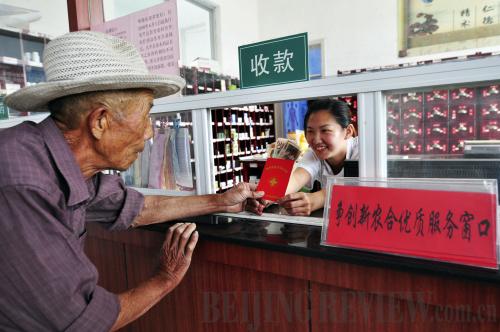|
 |
|
FARMER'S INSURANCE: Wang Shichang, a farmer in Miaojia Village, Zouping County in Shandong Province, receives reimbursement from the New Rural Cooperative Medical Scheme for his medical expenses at the village clinic on June 1, 2012 (DONG NAIDE) |
"Reform is China's biggest dividend and we must make sure that ordinary people benefit the most from the reform. This goal has guided health care reform for the last three years," said Li at a meeting of the Leading Group for Health Care Reform of the State Council, China's cabinet, on January 5.
Before the initiation of the latest reform, the public's complaints about the medical sector were mainly directed at difficulties seeking and paying for health care and the enormous gaps in quality of services between different regions as well as between urban and rural areas. While designing the reform, policymakers decided to strengthen the government's role in providing basic health care and enhance the fairness in its provision. The birth of this guiding principle was significant as it symbolized a reversion for the market-based resources distribution that dominated the medical sector for more than 20 years.
Between 2009 and 2011, the government invested about 1.52 trillion yuan ($244 billion) into health care, an increase of 1.24 trillion yuan ($199 billion) over the figure before the reform started. In 2011, private medical spending accounted for 34.77 percent of total health care expenses, the lowest proportion in nearly 20 years. Last August, six ministries jointly issued a policy to promote critical illness insurance among urban and rural residents so that the sick won't lose everything because of an illness.
The Central Government also set goals for local health care reforms, which are mainly evaluated by local governments' investment into these initiatives.
"China is a big country with a large population and unbalanced development in different regions. The poor conditions in China's community-level facilities particularly affected ordinary people's access to quality basic health services. These conditions required us to choose a reform path that was tailored for the country," said Sun Zhigang, Vice Minister of the National Development and Reform Commission.
Zeng Yixin, President of Peking Union Medical College, who participated in the drafting and revision of the health care reform program, said that ensuring the provision of basic health services, improving community-level medical facilities and instituting stronger regulatory systems are the critical success factors for China's health care reform. China has more than 50,000 publicly funded community-level medical facilities across the country.
Zeng said that ensuring basic health services was to make them affordable and build a cost-sharing mechanism. He explained that when people complained about the difficulties of receiving treatment, they mainly referred to seeing renowned doctors in top-rate facilities. "What motivates patients to queue up all night to make an appointment with prestigious doctors is their lack of faith in the quality of community-level medical services," he said, adding that for the last three years, the government has put improving community-level facilities high on its reform agenda by investing generously in upgrading their equipment and training their doctors.
In 2010 the Chinese Government released a plan to train up to 300,000 general practitioners within 10 years to satisfy the needs of community-level medical facilities. Under the plan, community-level general practitioners will provide primary care, treating acute and chronic illnesses. They will also provide preventive care for local residents.
"Once community-level medical institutions are equipped with qualified general practitioners, people would not all flood into large hospitals to treat even a mild condition," Zeng said. He suggested the government come up with more incentives to encourage qualified medical personnel with five years of training in a medical school and three years of clinical general practitioner training to work at community-level facilities.
Zeng said that an important measure for instituting stronger regulatory systems is the increased supervision on large hospitals to make sure their services are adequate and efficient. Health authorities in recent years have launched campaigns against rampant breaches of ethics codes, such as accepting bribes from patients or kickbacks from pharmaceutical companies, which contributed to the establishment of stronger regulatory systems. "The two initiatives of strengthening primary care and regulatory systems are mutually complementary, which are both indispensable to the success of China's health care reform," he said.
Cutting off interest chain
Hospitals making money through drug sales has long been regarded as a root cause of expensive medical bills and poor quality of medical services in China. Due to insufficient government funding, pubic hospitals have been allowed to supplement their expenditure by selling medicines with profit margins of less than 25 percent. However, in practice the markup often surpasses 40 percent or even 60 percent. Sometimes, physicians even prescribe unnecessary drugs for patients simply to meet a prescription quota set by their employers. Pharmaceutical representatives have also become infamous for lubricating the channels so that certain drugs are sold in hospitals and maneuvering profits that are distributed among doctors, hospitals and themselves.
To solve this problem, on August 18, 2009, the MOH and other government departments concerned jointly launched policies on essential medicines.
The state essential medicine list contains 307 varieties, including chemicals and finished products of traditional Chinese medicine. More importantly, they are all covered by the country's basic medical insurance program and enjoy a reimbursement rate remarkably higher than that of non-essential medicines.
Different provinces, autonomous regions and municipalities have added an average of 210 varieties of medicines to their own regional lists.
Provincial-level platforms for the centralized procurement of essential medicines have been established to seek procurement tenders from producers, while all essential medicines are required to be purchased directly from pharmaceutical firms.
| 